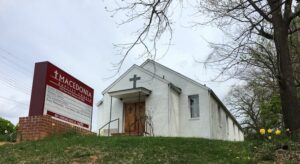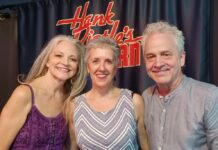
Atop a hill on the west side of River Road in southwest Bethesda, stands Macedonia Baptist Church. Built in 1920, it remains the most visible relic of a once-thriving Black neighborhood. The small white house of worship stands in front of the 18-story Kenwood Condominium built in 1965 and across a side street from a Bank of America branch where slave quarters once stood.
The community was built by freed slaves in 1869. Records show that in 1880, it included 24 households and 102 people. Other uses for nearby land together with restrictive covenants and segregationist policies restricted community growth. Around 1950, it consisted of about 62 homes with about 200 inhabitants, recalls former resident Harvey Matthews. It was founded on swampy real estate then cheap because it lacked agricultural use. It was sometimes called Grayville after local businesswoman Charlotte Gray.
The community developed a semi-pro baseball team, beer hall, swimming hole and the River Road Colored School, where Black children were taught until desegregation. In 1958, the Montgomery County Board of Education sold the school. The building remained until 1980 as a community center and dance hall, the site today of a television tower.
Times changed and the land became valuable for suburban development post World War II. The Black neighborhood was rezoned from residential to commercial, though nearby white residential areas were not. Furthermore, code changes in the 1950s required owners to hook up sewer lines at their own expense.
The community had begun a gradual decline during the Depression, when some residents had to sell their homes. Local historian Tim Willard wrote that the community “faced pressures to move by the 1930s and 1940s. By the 1950s, the pressure to move out became intense. Developers would take residents out, ply them with liquor, and intimidate them to sign papers to give up their land. Initially, they were told that they could continue to live on the property as long as they wanted but, after signing, they would be told that they had to move immediately.”
They were told they had to move because their houses lacked running water and didn’t stand up to code, Matthews remembers. Most families relied on well water and outhouses.
“You dropped the bucket down the well,” Matthews explains. Increased traffic on River Road and development of Little Falls Parkway brought further value to the real estate and pressure on inhabitants.
Residents scattered, some moved south into Washington, some north to other predominantly African-American neighborhoods in Poolesville, Rockville and Frederick.
Macedonia once asked for historic designation from the Montgomery County Master Plan for Preservation but didn’t get a response and hasn’t had the resources to push the matter, says Pastor Segun Adebayo. It also hasn’t found the resources to ask to be included on the National Register of Historic Places. (The register includes five other Macedonia Baptist Churches that list “black” and “architecture” as their significant areas.)
Adebayo assumed his role in 2016, though he joined the church in 1991. “The demographics have changed much since I joined,” he reflects of the one-time neighborhood house of worship. “It was predominantly women, many from Prince George’s County at that point….their children came for a while, then ceased from coming.” Attendance is down from 100-120 active participants to 80-90, including about 30 children.
Previous generations walked to church but now they come from Gaithersburg, Germantown and Prince George’s County. “They drive all that way to be part of Macedonia,” Adebayo says. Some members of the old families come “every now and then,” such as for special occasions “but they don’t come regularly,” he says.
Gas stations and other stores now line River Road north of the parkway. Three houses once stood where the Poly Clean Kenwood laundromat does. The last residents recall some of the businesses that still stand on the west side of the road, including the 7-11 opened in the late 1950s. Family-owned Talbert’s Ice and Beverage Service has been quenching thirst from the west side of the road since 1955. “I used to work there,” Matthews recalls.
River Road was originally built to transport tobacco to market, according to the Westbard Sector Plan of the Maryland-National Capital Park and Planning Commission adopted in 2016. The road was expanded from two to five lanes in 1962.
The Westbard plan states in “the 1890s, the Baltimore and Ohio Railroad began buying land in Westbard for the Georgetown Branch (now the Capital Crescent Trail). The right-of-way cut through existing farms and an African American neighborhood. The tracks were laid in 1909 and the line completed in 1910.
Primarily a freight line, the Georgetown Branch spurred development of a small industrial area in Westbard. The Georgetown Branch saw its last train run in 1985, but Westbard’s mixed-use character, which diversified over time, remained.”
In time, retail outlets replaced early-20th century businesses including “heavier industrial uses, such as rock quarries, concrete plants, stone working facilities and fuel oil storage and distribution,” the plan states.
The plan discusses the changing character, noting that “Westbard’s second wave of residential development occurred from the late 1950s to the 1970s.” It doesn’t describe the coercion used to remove inhabitants, though.
The area remains a mixture of high-rise apartments and commercial use. Ridgewells Catering fulfills menus for special events on the land just north of the church, on the site of the abode built in the 1930s, for a pillar of the community named Jimmy Dorsey.
At the north end of the neighborhood fronting the parking lot of the Kenwood Station Shopping Center anchored by Whole Foods, two other living residents of the community survived eviction: a pair of sycamores on what was the Matthews family’s small farm. “My mom and dad planted them. Mom had tulips,” Matthews remembers. “My dad had a few pigs and chickens….He trained beagle dogs to hunt rabbits and coons for white people.”
Trains on the railroad line would pick up men who commuted to jobs in downtown Washington. “They built the bomb shelter in the White House,” Matthews states. Other men worked as builders and stone cutters. Many women worked as caregivers and house cleaners. “We walked the railroad tracks to [downtown] Bethesda,” Matthews says.
Matthews’ parents, Milton and Dorothy Matthews, moved out in 1959 and the last families sold in the early 1960s. Among the last to sell, the Clipper family sold property it bought in 1929 in the winter of 1963.
The buyers of much of the property included Laszlo Tauber, who was not only a real estate developer but a surgeon, champion gymnast and philanthropist who died in 2002 and whose family still runs a charitable foundation in his name. He and his associates bought the land in 1956 to develop the Westwood Shopping Center west of River Road. And in 1959, they bought one of the last pieces of the community left over from the heirs of the previous owners, according to county real estate records.
Outside the church a few reminders remain of the neighborhood gone by. Dorsey and Clipper lanes near the church still bear the names of prominent community families.
“The church was the heart of the community,” recalls Matthews, who is retired and lives in the District of Columbia. The century-old church replaced one across River Road
in a swampy lowland drenched by too many floods.
But even before being forced out, the neighborhood was terrorized by Ku Klux Klan “visits” after dusk. Residents recognized the Klansmen wearing hoods at night as the same people who wore the Montgomery County Police uniforms by day.
“As a Black in the community, you had nobody you could go to. The police were the Klan themselves,” Matthews says. “They rode pickup trucks…and would hoot and holler.” They called names but stopped short of physical violence.
Many of the real estate and church records have been destroyed, some in fire. “They didn’t keep documents back then like they do now. In those days, they were destroyed,” Matthews explains.
Many community members have stayed mum about their ouster. “It is hard for them to talk about it because it is so very painful. They are still dealing with the injury their families had on River Road,” explains Marsha Coleman-Adebayo, wife of Macedonia’s current pastor.
“I call it the lost colony,” Matthews says. But Montgomery County may provide Graysville’s bygone times some more awareness, at least to those passing through it. The sector plan suggests that Montgomery County “(r)ecognize and preserve the African-American heritage
of the neighborhood through historical markers.”




